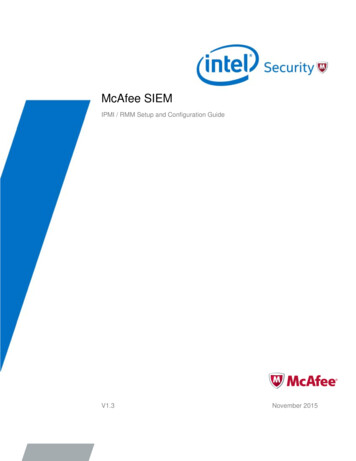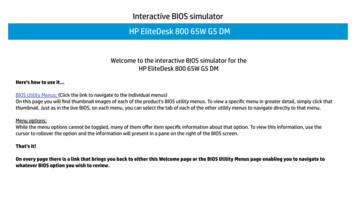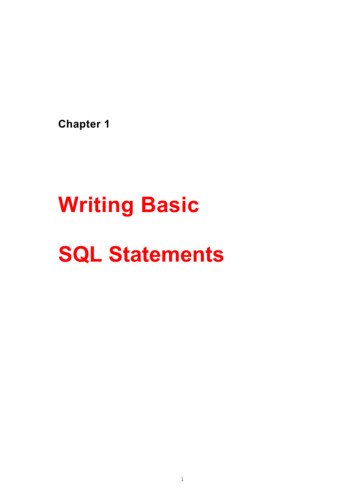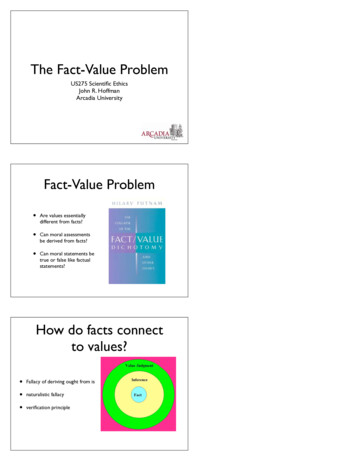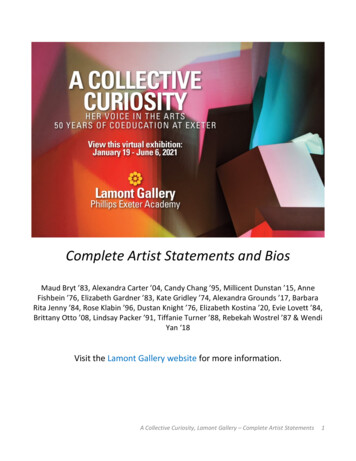
Transcription
Complete Artist Statements and BiosMaud Bryt ’83, Alexandra Carter ’04, Candy Chang ’95, Millicent Dunstan ’15, AnneFishbein ’76, Elizabeth Gardner ’83, Kate Gridley ’74, Alexandra Grounds ’17, BarbaraRita Jenny ’84, Rose Klabin ’96, Dustan Knight ’76, Elizabeth Kostina ’20, Evie Lovett ’84,Brittany Otto ’08, Lindsay Packer ’91, Tiffanie Turner ’88, Rebekah Wostrel ’87 & WendiYan ‘18Visit the Lamont Gallery website for more information.A Collective Curiosity, Lamont Gallery – Complete Artist Statements1
MAUD BRYT ‘83www.maudbryt.com@maudbrytARTIST STATEMENTIn my current work I use the simplest means to explore relationshipsbetween forms: ink, colors, paper, plaster. I find that a world ofOnly Now, 2020, Watercolorharmony and tension opens up in the play between a few simpleforms and a few colors, and working toward a dynamic equilibrium isa good metaphor for life. I carry my watercolors wherever I go, and I use them to take notes from lifeto start a conversation on the paper. I do the same with my favorite pen and paper, and most recentlyuse an iPad to draw also. The plaster sculptures are more involved in terms of time and technique, butit's the same form-to-form play.ARTIST BIOI grew up the middle of five children in New York and New Mexico, always drawing, photographing,and making things. I went to Phillips Exeter and then Harvard University for college, worked as afashion photographer for a few years, and then, with my husband, raised our daughters while paintingand sculpting, until now, when I can devote all my time to it. Some highlights of my painting careerhave been multiple exhibits on Nantucket Island of paintings based on old family photos, and in 2015when my portrait of my mother-in-law won acceptance to the BP Portrait Award competition and wasexhibited at the National Portrait Gallery in London. Some highlights of my sculpture career have beenexhibiting a large plaster construction in a group exhibit in midtown Manhattan, and in 2018 installinga new plaster sculpture along with some prints at the American University of Paris.A Collective Curiosity, Lamont Gallery – Complete Artist Statements2
ALEXANDRA CARTER owww.facebook.com/alexandraacarterARTIST STATEMENTThe cranberry, a tart, highly pigmented fruit, is a symbol of personalidentity. Having grown up on a cranberry farm in New England, my lifeis intimately tied to this berry, which represents both abundance andThe Passion of New Eve (for Günterfecundity but also tension with the patriarchal family hierarchy. The1964), 2018, Ink and imageberry is a repeated icon in my visual lexicon: the fruit is like a garnettransfers on drafting filmambrosia, an exalted potion that seeps through my paintings andintoxifies its subjects. Photographs of berries and botanicalillustrations replace and adorn parts of the female body. Breasts become globular appendages thatbubble up, guzzle down, shrivel, leak, and lactate. Made with layers of puddled pigment and collagedimagery on translucent drafting film (a.k.a. mylar), my paintings mimic explosive, liquid bodiessplashing out of their own skins. Influenced by folklore and mythology, I quote deities of jest, filth, lust,and light. Women embody the celebratory nature of the harvest alongside a certain burlesqueattitude, performing a sumptuous dance between maiden, mother, and crone. Wanton figures of mythand fairytale embroil themselves within the monstrous feminine and the maternal grotesque.ARTIST BIOAlexandra Carter (b. 1985 in Boston) lives and works in San Diego, California. She received an MFAfrom Goldsmiths University of London in 2015 and a BA from Rhodes College in Memphis in 2009.Recent solo exhibitions include “A Sense of Heat in Her Brain” at Luna Anaïs Gallery Los Angeles (2020),“Berries for Baubo” (2019), and “All gods are hot” (2018) at Radiant Space Los Angeles. Other soloexhibitions include Fusion Gallery (Turin, Italy), Southfork (Memphis), Projecto’ace Foundation (BuenosAires), and the Memphis Brooks Museum of Art. She has been selected for residency projectsnationally and internationally, including KulturKontakt Austria (Vienna), Qwatz (Rome), Graniti Murales(Sicily), Vice Versa Foundation (Goa, India), RECSIM (Jashipur, India), Galerija-Muzej Lendava(Slovenia), the Kentucky Foundation for Women, and a forthcoming residency at Saari in Finland.A Collective Curiosity, Lamont Gallery – Complete Artist Statements3
CANDY CHANG ‘95www.candychang.comInstagram: @candychanglandTwitter: @candychangARTIST STATEMENTLight the Barricades, 2019, Chineseink, photomontages, solar panels,aluminum, polycarbonate, vinyl,LED lights, hourglasses, concreteThere is a war on our attention. Each day we’re bombarded with somany distractions that it’s easy to neglect our emotional health. Asthe world has felt more uncertain, more tribal, and more alienating, I often find myself feeding myworst habits and yearning for rituals to help restore perspective. This has led me to think about thefuture of ritual in public life—new ways we might find emotional communion with one another, toremember that we are all walking wounded and that our shared struggles and desires far outweigh ourdifferences.ARTIST BIOThrough the activation of public spaces around the world, Candy Chang ‘95 creates work that examinesthe dynamics between society and the psyche, the aesthetics of handwriting, and the value ofanonymity in a performative age. Trained as an urban planner, she channeled her emotional questionsinto her work after struggling with grief and depression. Her participatory public artwork Before IDie reimagines our relationship with death and with one another in the public realm, and has beencreated in over 5,000 cities worldwide. Her most recent work, Light the Barricades, is a series ofelectrified shrines for contemplating inner obstructions and will be traveling to The Mint Museum inCharlotte, North Carolina in 2021. She is a TED Senior Fellow, Urban Innovation Fellow, and WorldEconomic Forum Young Global Leader. Her work has been exhibited in the Venice ArchitectureBiennale, Tate Modern, and Museum of Modern Art.A Collective Curiosity, Lamont Gallery – Complete Artist Statements4
MILLICENT DUNSTAN mindblown.nyc@queenmillicentgraceARTIST STATEMENTThese images of my work represent my world and thought process asI strive to create garments that are less harmful to the environment.My methods of construction take from what already exists and myinspiration stems from punk and countercultural fashion. I approachmy work with a do-it-yourself attitude and a goal to subvert thenorms of mainstream fashion.ARTIST BIOPlastic Fantastic Jacket & Pant,Spring 2019, Upcycled fabrics,bubble wrap, plastic bags,electrical tape, upcycled chainsMillicent Dunstan ’15 is a New York based designer and fine artist with a BFA in Fashion Design fromParsons School of Design. She has experience in a variety of creative areas from fashion and graphicdesign to styling, modeling and art direction. Her work exists in the world of subversive fashion andsustainability. She has been featured in Urban Outfitters, Milk Studios, Nicotine Magazine, The Cut andmore. She continues her work through her small brand, Mindblown with her partner Ben Lucas Jones.ANNE FISHBEIN ‘76www.annefishbein.comARTIST STATEMENTMy photography is rooted in the real world as part of the tradition ofdocumentary photography. The real world evolves. It changes andthis interests me both as a thoughtful concept and as a photographicThe Racetrack Project, Photographstudy. My photographs look at the real world, how it is graduallyaltered and how it references its past. The camera as a documenting tool is a great instrument for thispursuit. My projects do not have an end point unless the idea itself completely disappears. I continueto add to all the projects I’ve been working on; some having begun as far back as my college days.What I’ve ended up with is an interesting archive of images which allows me to ponder the way placesA Collective Curiosity, Lamont Gallery – Complete Artist Statements5
change over time or blur the indictors of the photograph’s date of origin. The racetrack project, instanding with the rest of my projects is a work in progress. It is not finished so what I present is arepresentative sample of what I have to date.The culture of horse racing and its anachronistic environment has presented a great photographicopportunity for me. Coming from a family interested in horses and horse racing, I’ve always had somefamiliarity with it. This is often not the case with projects. I’m usually fueled by a sense of discovery. Indocumentary photography I think we are often drawn to learn about something new and unknown andare less inclined to wonder about the things that have already been integrated in to our lives long ago.This project began to come together locally in Southern California one day through a casual trip to thetrack with friends. On that day in particular for some reason, I was really struck by a kind of suspensionin time that I observed. Consequently, I was compelled to shoot more than usual and in so doingexperienced something very rare that has persisted throughout the project. Something that is no smallissue: people didn’t seem to mind when I photographed them. They didn’t even notice. On rareoccasion, when they did notice, they sometimes even liked it. This was no small thing. I was invisible. Iwas finally a fly on the wall – every documentary photographer’s fantasy. What this phenomenonmeans is I can observe and create images that are not about the photographer and subjectacknowledging one another but are instead about creating images of what is really happening in themoment. What was and is happening at the track is a culture long ago established, diminishing in itsgrandness and popularity in an environment decades old, frayed around the edges but still compellingits followers to maintain the style and tradition to some degree the way it always has been. I have feltan increased urgency to pursue this fading culture because as Tom Pedulla put it in USA Today “Oncethe sport of kings, horse racing is now galloping toward uncertainty.” The racetrack, although itsfuture is uncertain, is a great place to study humanity. I love Hollywood Park in particular. It is the trackmost likely to shutter its doors the soonest. The land is valuable and I’ve been told that as soon as theeconomy turns around, there will be no point in reserving the land for an unprofitable enterprise. Allhorseracing tracks are old. Hollywood Park, although beautiful, was never built to distinguish itselfarchitecturally so will also not insure itself a protective historical status.It is Hollywood Park’s location in working class Inglewood and the fact that it wasn’t the most elitelocation that makes it more significant and interesting to me as a photographer. The attendancenumbers are increasingly low but the people who do go are often local workers, still in uniform. Thereare also patrons and staff who have been connected to the place for fifty or more years, a loyalty Iobserved at the other tracks as well.It has often been said that black and white photography is more about metaphor and colorphotography about information. Black and white imagery has also dated itself as a medium suggestingthe past. For these reasons I have chosen to create the images in black and white and not digitally buton film. Less evident to most viewers of photography but critically important is the difference inappearance between a digital pixel and what we refer to in film as “grain.” In either case, it ishundreds of these miniscule properties that make up what a photograph looks like. Although subtle,the appearance affects perception in a way not unlike the way variations in sound media affect musicinterpretation, or the quality of an ingredient affects a recipe. On a scientific level, one way to see thedifference is to compare a digital image magnified greatly on the computer screen next to theA Collective Curiosity, Lamont Gallery – Complete Artist Statements6
magnified results of a scanned film image. Even if the viewer lacks a conscious vocabulary about thisissue, based on one’s own accumulated experience and perception, it impacts one’s interpretation.Photographic style has the same effect. A good example would be the stylized, widely popular iPhoneHipstamatic application. This application applies a vignette and a sepia hue to images which impactwhat Carl Jung referred to as “our collective unconscious” tapping in to associations which each of usbelieves represents what “the past” used to look like. Interestingly, I have for a long time deliberatelycreated a vignette in my images while taking the picture in order to quietly influence the viewertowards this association with an earlier time. By way of explanation in photographic history, all earlyphotographic images at smaller aperture openings would result in vignetting due to the flaws andlimitations of early lens design. I have observed that when I incorporate vignetting into my black andwhite images, along with certain subject matter and style of composition, the perception is often thatthe results are quite old.The other essential component to the equation of why my pictures look the way they do is the primarycamera I’ve been using for this project, the medium format film, Hasselblad. By way of understandingthere is much that can be said about this camera. First of all, the larger the format, the finer theresolution of the resulting image which is not just nicer to look at but is another shared componentwith earlier photography. Hasselblad cameras have always used Zeiss optics which are considered tobe the most precise. Zeiss optics allow me to work in available light with more responsive results and abroader range of subtle tone and shadow. This has been crucial during the racetrack project, as I’vediscovered that the results, I’ve been most interested in have come from night racing at HollywoodPark. I generally don’t use a tripod because it slows me down and it’s a bit of a spectacle (interferingwith that “fly on the wall” potential I described earlier.) The newest observation I’ve made regardingthe use of this camera is its ability to convey worthy intentions to observers such as photo subjects andsecurity. The camera I use is somewhat beaten-up. It is around thirty years old and doesn’t resembleanything being used today. I can’t quite explain every reason why I go so unnoticed and unchallengedat the track but it has been observed that my old, odd looking camera charms and reassures people.In addressing the current results of this project, they’re mostly divided in to two categories, the racingside and what is referred to in the horse community as the “backside” or the area with the stables.The results I’m most interested in so far are the pictures from the frontside which best explore theculture. I’m very interested in the athletics of racing and want to look closer in to the world of thejockeys. So far, I’ve only been able to get last minute portraits of them at the track. I need to establishrelationships with individuals to get further in to this aspect and this I will do gradually. In the largersense of how I work and the nature of my projects, I still consider myself at the beginning of a longterm study. The direction it goes will change as I continue to observe the topic and the results.In the larger sense of how I work, I noticed that my attitude about the project and the sport wasdramatically altered by something I witnessed at the track one day. It also showed me somethingabout my priorities as a photographer. It was a Sunday and I had just arrived at the track. I was seatedat a table loading film into my camera when I happened to glance up at a live TV monitor displaying thefirst race of the day. Customarily at the track I get caught up in studying people, betters get caught upin betting and I think it’s easy sometimes to forget to truly observe the horses and how beautiful theyare when they’re running. It was during one of these thoughtful moments that I saw the lead horsesuddenly and violently collapse. It was instantly evident that the force of the fall would lead to theworst possible outcome. All I could do was look down with my eyes closed for several minutes.A Collective Curiosity, Lamont Gallery – Complete Artist Statements7
Eventually I decided to walk over to the railing closest to where it had happened. There I saw a horsetrailer, an ambulance and what I now perceive as the symbol no one ever wants to witness: a greencurtain, possibly 50 meters across on a metal frame stationed to conceal the activities behind it. I stoodthere quietly watching until the curtain was folded up and the trailer and ambulance drove off. Soonafter, a track official came walking briskly by on the other side of the railing. I got his attention andasked how they were doing. “Jockey’s in first aid” he said. “What about the horse” I asked fearfully.“Not correctable” he replied. What a revealing answer I thought. Perhaps it was strategically worded totake the emphasis off of the loss of a living thing but for me it had the opposite effect. I just keptthinking about the poor beautiful horse doing what it did naturally but in unnatural conditions and nowgone. For a while I couldn’t get my mind off it. I went home that day and started researching“Tokubetsu” whose name I learned means “special high ninja.” I wanted to learn about this three-yearold horse, now dead, partially to honor his life and counter the track official’s chillingly indifferentwords on the matter. I know that horseracing is dangerous. All the thoroughbred riders, including theexercise riders, the trainers and jockeys have suffered multiple injuries because thoroughbreds arehigh-spirited and unpredictable and falling off and sometimes under one or several running horses isnot uncommon. The horses, ultimately less talked about are fragile and the intensity of what they domakes them especially at risk of injury and unfortunately many of these injuries are “not correctable.”It was one thing to be vaguely aware of the risks but witnessing an incident has had long-lastingeffects. As with all sports, horseracing is a business so it is pretty clear why the harsh realities areconcealed. I had the bad judgment a few years ago to attend a bullfight in Spain. This meant I endedup watching thousands of people cheer on a bull being tormented and then killed in an arena.Afterward I decided to wander around behind the scenes with my camera and to the surprise of boththe participants and me, I came upon a room where several celebratory men were stringing up thedead bull by its hind legs. I managed to get one documenting image of this grim situation before theylooked over in shock and slammed the door.Horseracing is not bullfighting and it’s not my intention to make a comparison. The stories of bothTokubetsu and the bullfight have resulted in reflection about the experience of these harrowingmoments –about looking and not looking, seeing and not seeing and then at the point of regainedclarity, how to proceed. Having witnessed a tragedy has now made me more aware of unexpectedconsequences. This has likely affected both what I experience at the track and how I photograph. Theday Tokubetsu died, as I made my way down to the railing, I was completely unaware of what thespectators were doing and only later realized that the subject might have been a very telling set ofphotographs. But I learned something about myself that day concerning an issue that photographerswrestle with: can we always remain detached in an effort “to get the shot?” I realized, and possibly tothe sacrifice of images, that I sometimes can’t. On that day, I forgot that I had a camera. I’ve oftenthought about an essay I read my first year out of college about a first-person account of twophotographers who both found themselves in a chain-reaction car accident on a bridge in Manhattan.One photographer saw a distressed person in a wheelchair being wheeled quickly in their directionaway from the unfolding chaos. The photographer describing the incident in the essay wrote about hisimmediate realization of what a perfect Pulitzer-Prize winning moment it was. But he was also acutelyaware of his sense of humanity for the emotional pain he was witnessing by the person in thewheelchair and it prevented him from exploiting the moment with his camera. Additionally, he got inbetween the other photographer and the subject to prevent any kind of photographic record. MyA Collective Curiosity, Lamont Gallery – Complete Artist Statements8
reaction to that story hasn’t changed over the years but it still occupies my thoughts. I don’t think onephotographer should have imposed his will and interfered with another. There is a lot of painful truthin the world and evidence in the form of photographs can both enlighten and alter how we see theworld. There is a lot to consider involving this subject and each photographer’s responsibility andconduct. But on the day, I saw a horse die and learned something about how it’s perceived by some inthe horseracing community, I learned something about myself. I know that in the future I will have anobligation to try to keep my eyes open in the face of tragedy at the track. There may be usefulness inthe purpose of what I might photograph. We may learn something about ourselves and possibly aheightened awareness of our responsibility to protect the horses. Much was gained from that lifelesson at the track but I would give up what I learned and even the possibility of better photographs forTokubetsu to still be alive.ARTIST BIOAnne Fishbein ‘76 received a B.S. in communication from Northwestern University in 1980 and anM.F.A. from Yale University in 1985. Solo and group exhibitions include the Los Angeles CountyMuseum of Art, San Francisco Museum of Modern Art, California Museum of Photography, Zocalo TwoMetro Station (Ministry of Culture, Mexico City), The Art Institute of Chicago, Carnegie-MellonUniversity Art Gallery, El Motin de Los Angeles (Barcelona, Spain), and Mayer Art Center, Exeter, NewHampshire. Among the many museums and collections holding Fishbein's work are the Los AngelesCounty Museum of Art, The Art Institute of Chicago, The Museum of Modern Art (New York), NationalGallery of Canada, Norton Family Collection, and the San Francisco Museum of Modern Art.Anne Fishbein continues to work on projects both with film and digitally while earning a living througha combination of editorial and corporate assignments and teaching. Her monograph On The Way Homewas published by Perceval Press.ELIZABETH GARDNER acebook.com/dustyroadpressARTIST STATEMENTFire on Ice, 2019, PhotographI walk, take photographs, write; I can’t do one without the other two. I am a sky swimmer. It’s been myjam, my religion — every step a prayer, a way through. There’s been no better way for me to staygrounded and keep moving through the tougher stuff of life than to just get outside for a walk — andtrust in the simple magic of ordinary things, the rhythms of the natural world, and the wisdom ofA Collective Curiosity, Lamont Gallery – Complete Artist Statements9
trees. Most days, I walk the backcountry roads and woods trails that beckon with the first light.Sometimes I’ll head out for several hours, covering ten or more miles, stopping to chat with neighbors,sing to the cows, watch the birds rouse the ancient sycamore, and visit my favorite barn, beforereturning home to process, write. Something changes for me out there — the sky opens up, a sense ofyonder rising with the distant hills and river fog, within me, too, and suffusing my whole being with asort of reverie and magic. This space — where I can bring my awareness to the tiniest of shifts in thelandscape within and without, breathe into just being, and cultivate presence, stillness, and resilience— has been deeply healing and fortifying.It took me a long while to give myself permission to step into my creative space fully and unabashedly— and I am grateful for the many people who have nudged me back into that space — and back intomyself — over the years: my book designer, Bruce Kennett (‘67), who has always helped me imaginethe possibilities; my sons, Luke and Dom and friends far and wide who inspire me with their owncreativity and willingness to go off map. I chose these five images out of the thousands I’ve taken overthe past several years mostly because of the way I remember feeling when I captured each of them. Iremember what was swirling in my head, my heart — the softening I experienced in each moment as Istood transfixed by a certain kind of light as it hit the water, illuminated the barn, the skies, me.I don’t own fancy camera equipment. If I did, I might lose the spontaneity of my captures, the way Isee. I’ve used three different iPhone cameras to take these images, tucked into a pocket as I’ve set offto clear my head, chase a rainbow, lose myself in the eloquence of the concrete. I often visit the samespots over and over again, enabling me to notice the tiniest, subtle shifts and quiet harvesting of theseason as the landscape is once again tenderly transformed into something new. Each time different —echoes of myself, and back again. I first started taking photos on my tiny 5S, which I later bequeathedto my mother, and on which she’d tap out long texts followed by a string of random emojis and hersignature “Loving you, Mom” in the months before she died — and which somehow captured a oncein-a-lifetime sky, just two days after the Summer Solstice back in June of 2015, when I walked to thebarn and stood awash in wonder for over an hour, as the skies above (and only above the barn, I laterdiscovered) cycled through otherworldly pinks and colors I’d never seen before and knew I might notever see again.My faithful 6s accompanied me on many 10-plus-milers all over town, and captured thousands ofmoments of beauty for me, including the image, Fire on Ice, which I also chose for the cover of my firstbook, Here. In the Undertow of Wonder. Taken at my secret spot, where I often go to catch the light,watch the beaver doing his thing, and listen to the rural philharmonic settling in for the night, this shotwas taken back in early March, 2019. I remember the skies were raging with a fiery sunset, and theclouds were threatening to unleash a Dark Mark, so I dashed off to see where it all might touch down,and found the fire hitting the snow and ice just so — no beaver in sight.Finally, I purchased my most recent iPhone, an XR, just before a two-week trip to Ireland and the UK inthe summer of 2019, so I could go unbridled into the landscape and take as many photos as I wanted— which I did, of course, thousands of them, of a landscape with which I felt an immediate kinship, andreminded me of my own here in Gill. The last three shots were captured with the XR. I rememberwaking early, as I often do, on the morning of December 1, 2019, and being pulled outside by the hintA Collective Curiosity, Lamont Gallery – Complete Artist Statements 10
of an orange sky. I walked down to the barn, and there she stood, Sunrise Barn, one eye opening tome, skies blazing with the promise of a new day — another chance to remake our world.When the pandemic hit, it was all I could do to spend as much time outside as possible. I am so luckythat I can do that safely, and stay connected to the landscape, friends and neighbors, myself — andmost especially, some grounding shimmer of hope that we would get through. Pandemic Spring, takenduring a long walk on April 19, 2020, represents to me that rousing sense of the burgeoning springwithin, a hint of fresh new growth greening the edges, colors blooming the sky, water. Something tolook forward to. In August, a veritable moshpit of sunflowers in front of the barn danced in thesummer heat, and I captured many images of Sunflower Barn at different times of day and nightthat showed the rollicking, riotous sunflowers in full bloom. So much joy! We all need more of that.Storms rage on, the landscape shifts and cycles endlessly — and the sky above splinters, mends, opensagain — echoing my own heart. The barn stands at the same time strong and vulnerable, bending everso slightly to the elements but tending, too, to its own island of calm within — one eye skyward, therest firmly rooted in soil strengthened by the generations that have farmed here.As I’ve navigated my own ever-shifting landscape of love and loss, grief and joy, too, I’ve tried tochannel the barn’s grace, the ancient wisdom of the land — standing on my own, weathering whatevercomes with a firm foothold in the ever-changing skies and fields, in the ancestral stories crisscrossingthe hills — and in the surety of connection. Though we often feel alone, we cycle through the seasons,this life, together. Especially now, we must stand together at the intersection of heart and landscape,where the natural world conjoins with and reflects our own essential nature, and back again —reminders that we are all just iterations of the world’s atomic creativity, part of the same living,breathing, interconnected universe. This world — wherever it is for you, the same — lives and breathesfor us. To be able to be truly, fully present here, to match breath and beat of heart, to soften theknotted places and open instead to the beauty and majesty of morning in surround sound ricochetingin the chambers of your own heart.well, it’s everything, isn’t it?ARTIST BIOElizabeth Gardner started walking and writing to reframe her world when she was very small. Losingherself in the wilds of wherever she was, in those hidden pockets tucked just out of sight — climbingtrees, hunting for salamanders, collecting che
illustrations replace and adorn parts of the female body. Breasts become globular appendages that bubble up, guzzle down, shrivel, leak, and lactate. Made with layers of puddled pigment and collaged imagery on translucent drafting film (a.k.a. mylar), my paintings mimic explosive, liquid bodies splashing out of their own skins.


